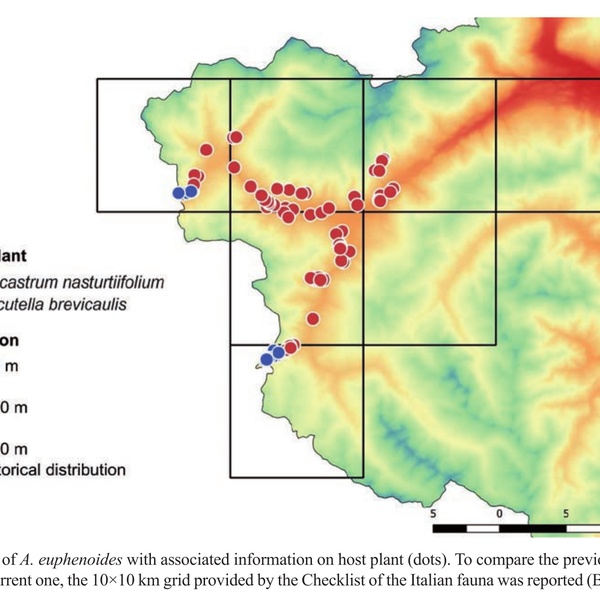The Anthocharis euphenoides beyond yellow
Sept. 25, 2025
It is not just a matter of color related to the wings of a butterfly, but the solution to a small mystery about its eating habits. As we know, when it comes to food, Lepidoptera are very selective because they primarily feed on very specific plant species, especially in the caterpillar stage. In the case of the Anthocharis euphenoides, also known as the Provençal Aurora, the plant considered its preferred host may not be what was previously believed, at least in the Susa Valley. But let's proceed in order.
Butterflies are among the insects most sensitive to environmental changes and, in Europe, many species are experiencing a rapid decline. Among these is the A. euphenoides, a lepidopteran with a characteristic yellow-orange pattern on its wings, distributed in a fragmented and localized manner in our country. Its presence is mainly known in the Central Apennines, the Pollino Massif, and some western alpine valleys, including the high Susa Valley, which represents the northern limit of its Italian range.
A recent study titled Beyond yellow: host plants of Anthocharis euphenoides in NW Italy, conducted by researchers Luca Anselmo, Enrico Caprio, and Simona Bonelli from the Department of Life Sciences and Biology of Systems at the University of Turin, investigated the ecology of this species in depth, aiming to clarify which host plants are used by females to lay eggs. Understanding this aspect is crucial: oligophagous butterflies, like A. euphenoides, depend on a few plant species for reproduction, and any misidentification can compromise conservation efforts.
Historical literature reported the main plant as Biscutella laevigata, widespread in much of the Alps. Yet, after two years of field research in Susa Valley during the summers of 2023 and 2024, the researchers observed something different: the butterfly primarily uses Erucastrum nasturtiifolium, a brassica with yellow flowers, previously reported as a host only in France and Spain. To a lesser extent, egg laying was also found on Biscutella brevicaulis, a species typical of calcareous high-altitude gravels, whose association with the Provençal Aurora had never been documented before.
Conversely, the use of Biscutella laevigata was never detected, despite its abundance in alpine pastures. This discrepancy suggests that there may have been errors in botanical identification in the past, repeated for decades in subsequent publications.
The investigations also revealed that the species is capable of reaching up to 2055 meters in elevation, about 300 meters higher than previously known. This rise may reflect an adaptation to climate change, which is pushing many alpine butterflies to greater altitudes. Nevertheless, the overall distribution in Susa Valley appears to be contracting: in some historically known locations, the butterfly is no longer present, likely due to the decline of host plant populations linked to the encroachment of forest after the abandonment of pastures.
The results of the study provide valuable insights for the management and conservation of the species. Maintaining the open pine forests, preserving the natural dynamics of river terraces, and safeguarding unstable calcareous gravels are key actions to ensure the survival of host plants and, consequently, of Anthocharis euphenoides. In terms of the territories managed by the Protected Areas of the Cottian Alps, the Provençal Aurora has been observed in the Natura 2000 sites of Les Arnauds and Punta Quattro Sorelle, as well as along the riverbank of the Dora a few hundred meters from the boundary of the Gran Bosco di Salbertrand Natural Park. In addition, the butterfly is also present in the sites managed by the Metropolitan City of Turin at the Xerothermic Oasis of Oulx – Auberge and Oulx – Amazas.
This research demonstrates how accurate knowledge of the ecology of rare and localized species can reveal new information and overturn entrenched beliefs. A fundamental step for the protection of biodiversity in the Cottian Alps, where every flower and every butterfly tells the delicate balance between nature and change.
The full article is available here.
You might also be interested in...
- campaign Climate change is pushing birds higher.
- campaign The thyme of the Cozie Alps Parks on Geo
- campaign The migrations of ibexes and climate change
- campaign Monitorare gli ortotteri: una sperimentazione nei Parchi Alpi Cozie
- campaign A nudge to comply with the regulations
- campaign Farfalle e cambiamenti climatici: un nuovo articolo scientifico
- emoji_nature Apollo
- shopping_cart Cave e miniere dell'Alta Valle Dora - cahier n°26
- tactic Alcotra BiodivTourAlps
- tactic Life PREDATOR
 Research
Research



